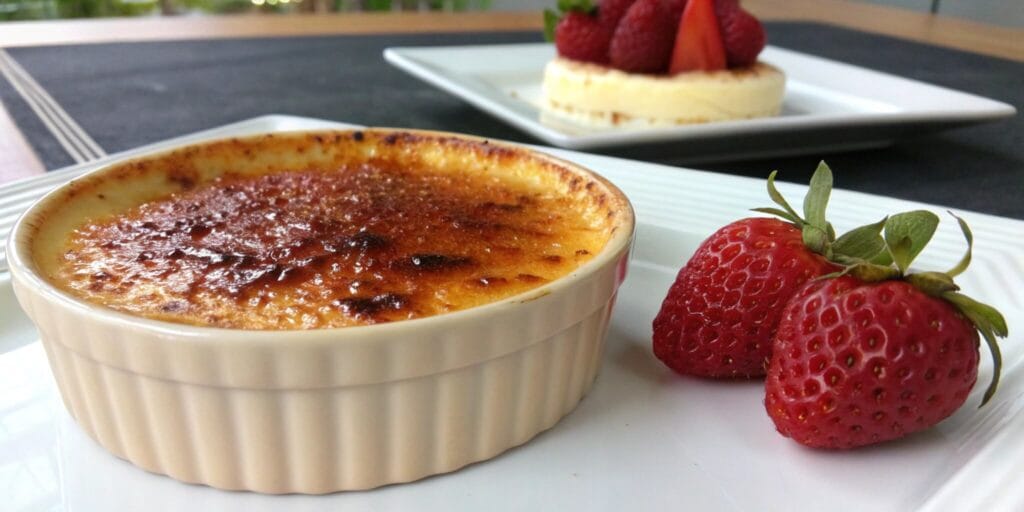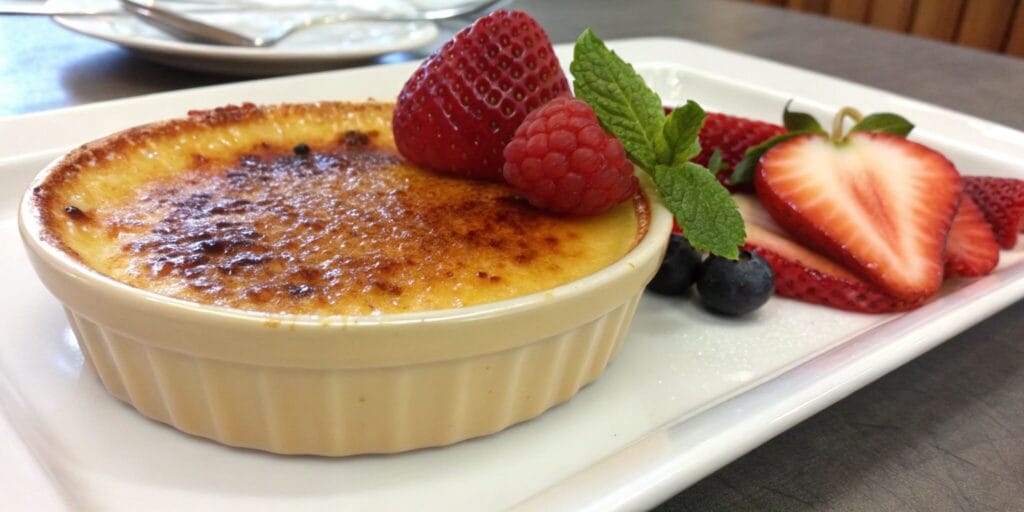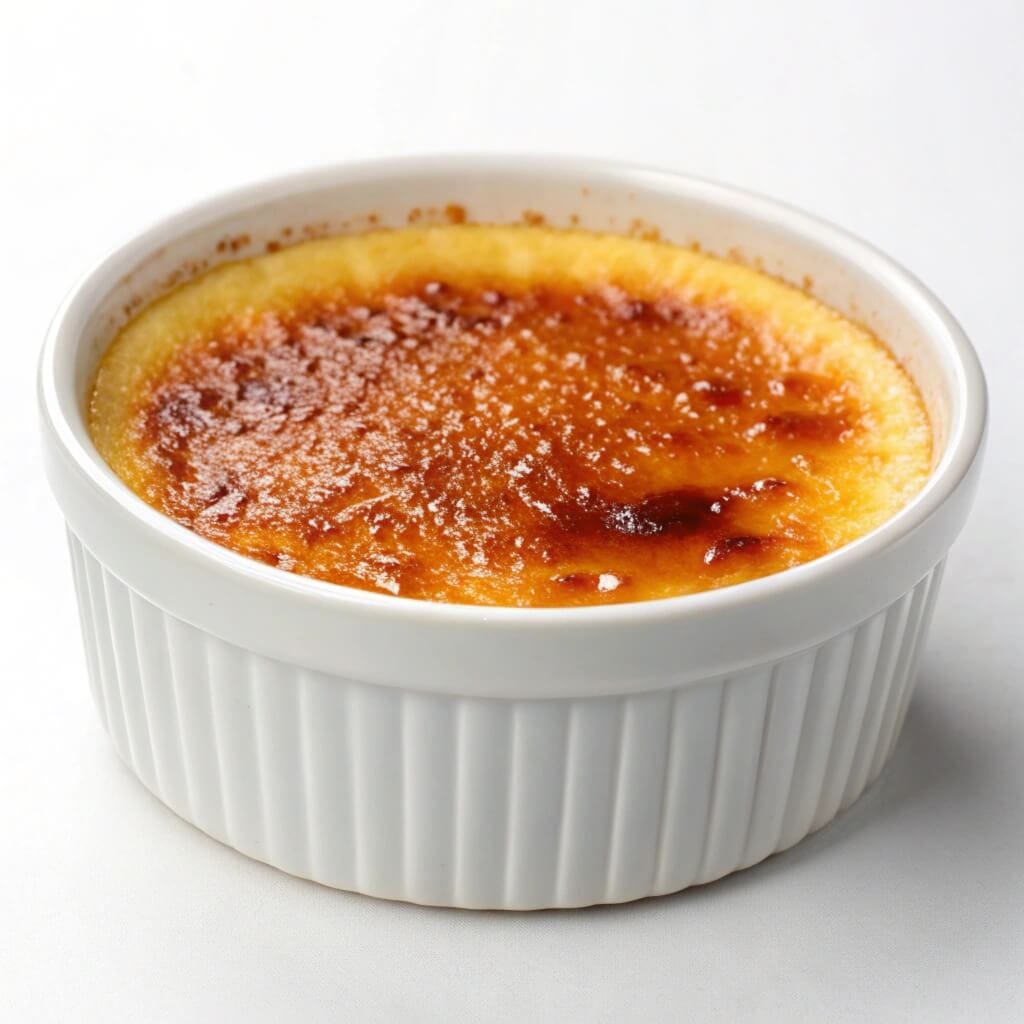Introduction to Crème Brûlée
Crème brûlée is a dessert that has enchanted food lovers for centuries, with its delicate balance of textures, luxurious flavors, and rich history. At first glance, it might seem like just another custard dessert, but its signature caramelized sugar crust and creamy custard base set it apart. This article dives into what makes it so special, exploring its origins, preparation, and why it continues to captivate taste buds around the world.
What is Crème Brûlée?
At its core, crème brûlée is a custard-based dessert topped with a thin layer of caramelized sugar. The contrast between the creamy, smooth custard and the crisp, crackling caramel layer makes it an indulgence like no other. Typically served in a shallow ramekin, it’s a treat for both the eyes and the palate.
But what is so special about crème brûlée? The answer lies in its simplicity. The dessert uses just a handful of ingredients—cream, egg yolks, sugar, and vanilla—but when combined, they create a masterpiece of flavor and texture. Its versatility also means it can be enjoyed plain or infused with exciting flavors like citrus, coffee, or even lavender.
Origins of the Name
Crème brûlée translates to “burnt cream” in French, referring to the caramelized sugar topping that crowns the dessert. This literal yet poetic name captures the essence of the dessert, emphasizing its signature feature. While the French name is most widely recognized, similar desserts in other cultures have slightly different names, such as “crema catalana” in Spain.
Why It Captures Hearts Globally
There’s something universally appealing about crème brûlée. The act of cracking through the caramelized sugar with a spoon is oddly satisfying, and the custard beneath provides a luscious contrast. Beyond its taste, crème brûlée exudes a sense of sophistication. It’s a staple on fine-dining menus and often associated with celebration and indulgence. Whether enjoyed at a fancy restaurant or made at home, crème brûlée has an undeniable charm that transcends borders.
Historical Journey of Crème Brûlée
The Earliest Recorded Recipes
The origins of crème brûlée stretch back centuries, making it a dessert steeped in culinary tradition. The first documented recipe appeared in a 1691 French cookbook, Le Cuisinier Royal et Bourgeois, but the concept of a creamy custard dessert existed long before that. In fact, similar dishes can be found in ancient Roman cooking, where a mixture of milk and eggs was thickened over heat. This early innovation paved the way for the refined custard we know today.
Interestingly, variations of crème brûlée popped up across Europe, with notable contenders being Spain’s crema catalana and England’s burnt cream. While these dishes share similarities, the signature caramelized sugar crust remains the hallmark of crème brûlée’s French identity.
How France Became Its Signature Homeland
Although other countries claim versions of this dessert, crème brûlée became synonymous with French cuisine. By the late 19th century, it graced the menus of high-end French restaurants, solidifying its reputation as a luxurious treat. The French perfected the technique of caramelizing sugar using a blowtorch, a method that adds to the dessert’s theatrical presentation.
Cross-Cultural Adaptations Over Time
As the dessert traveled beyond France, it took on unique flavors and twists. In Asia, for example, matcha (green tea) crème brûlée has gained popularity. Meanwhile, in the U.S., chefs have experimented with everything from pumpkin spice to bourbon-infused versions. Despite these changes, what is so special about crème brûlée remains its ability to retain its essence—a perfect blend of simplicity and sophistication.

Anatomy of the Perfect Crème Brûlée
The Ingredients: Cream, Sugar, Vanilla, and Egg Yolk
At first glance, crème brûlée seems deceptively simple. Its main ingredients—cream, sugar, vanilla, and egg yolk—are pantry staples. Yet, when combined, they transform into a luxurious custard base that melts in your mouth. The cream provides richness, while the egg yolks lend structure. Vanilla is the star flavor, offering a warm and aromatic undertone. Even the sugar serves dual roles: sweetening the custard and creating the crunchy caramelized topping.
The quality of these ingredients plays a huge role in the final result. For instance, fresh vanilla beans elevate the flavor, while high-quality cream ensures the custard’s velvety texture.
The Caramelized Sugar Layer
What truly sets crème brûlée apart is its caramelized sugar crust. This golden-brown layer is achieved by sprinkling sugar evenly over the set custard and applying intense heat—usually from a culinary torch. As the sugar melts and hardens, it forms a brittle shell that shatters delightfully with the tap of a spoon.
This contrasting texture is what makes crème brûlée unique among desserts. The crispiness of the sugar perfectly offsets the smoothness of the custard, creating an unforgettable sensory experience.
Texture and Temperature Balance
The magic of crème brûlée lies in its balance. The custard must be creamy yet firm, a feat achieved by careful baking in a water bath to avoid curdling. Additionally, it’s served slightly chilled, which enhances the contrast with the warm, freshly torched sugar topping.
Ultimately, what is so special about crème brûlée is its ability to deliver contrasting textures and temperatures in every bite, making it a standout among custard-based desserts.
Why Crème Brûlée Is a Trendsetter
The Sensory Joy: Crunch and Cream
One reason why crème brûlée is so special lies in its unique sensory experience. From the moment you crack the caramelized sugar crust with a spoon, this dessert engages multiple senses. The contrast between the brittle topping and the velvety custard below creates a delightful combination that’s hard to resist. Each bite offers the perfect balance of crunch and creaminess, a textural harmony that makes crème brûlée unforgettable.
Moreover, its visual appeal plays a role in its popularity. The golden sheen of the caramelized sugar, often accented with a sprig of mint or fresh berries, adds an air of sophistication to any table setting.
Influence in Pop Culture
This dessert has cemented its status as a culinary icon, often featured in movies, TV shows, and social media. It represents luxury and indulgence, making it a frequent choice for romantic dinners and special celebrations. Its role as a staple in fine dining also elevates its reputation, giving it a trendy edge that resonates with foodies around the globe.
A Dessert for Special Occasions
Whether it’s a wedding, anniversary, or fancy dinner party, crème brûlée is often chosen for its elegance. It’s easy to prepare ahead of time, allowing chefs to torch the sugar topping just before serving for a fresh, dramatic effect. This makes it a perfect option for events where presentation matters as much as taste.
Variations and Innovations
Classic vs. Contemporary Recipes
Traditional crème brûlée keeps things simple with vanilla as the primary flavor, but chefs around the world have introduced exciting variations. Modern recipes might feature bold ingredients like espresso, chocolate, or even liquor, creating unique twists on the classic dessert. Despite these innovations, the essence of crème brûlée—a creamy custard with a caramelized crust—remains untouched.
Flavors Beyond Vanilla
If vanilla isn’t your favorite, there are endless ways to enjoy this dessert. Fruit flavors like passion fruit or raspberry add a refreshing tang, while exotic spices like cardamom or cinnamon offer warmth and depth. These variations cater to a wide range of palates without compromising what makes it so special.
Dietary Adaptations
With dietary preferences on the rise, crème brûlée has also evolved. Vegan versions use coconut milk or cashew cream instead of dairy, and sugar-free adaptations cater to those watching their sugar intake. These alternatives prove that anyone can savor this timeless dessert without sacrificing flavor or texture.
For more delicious recipes, check out Kamala Recipes’ article library for inspiration on crafting decadent desserts or reinventing classic dishes.
Making Crème Brûlée at Home
Essential Tools and Techniques
If you’ve ever wondered what is so special about this recipe, making it at home will show you. This dessert is surprisingly simple to prepare with the right tools. Start with a shallow ramekin to ensure even baking. A reliable kitchen torch is essential for caramelizing the sugar topping—though a broiler can work in a pinch.
To create the custard, gently heat cream and vanilla, whisking it with sugar and egg yolks. The trick is to temper the eggs by gradually adding the warm cream to avoid curdling. Baking the custard in a water bath (a roasting pan filled with hot water) helps it cook evenly and prevents cracking.
Tips for Perfect Caramelization
Achieving that iconic caramelized sugar topping takes a little finesse. Sprinkle an even layer of sugar over the chilled custard and use a kitchen torch to melt it. Move the flame in circular motions for consistent browning. The result? A golden, glassy crust that’s irresistible.
Common Pitfalls and How to Avoid Them
Even seasoned cooks can encounter issues when making crème brûlée. Avoid overbaking, which can lead to rubbery custard. If the sugar burns too quickly, it can turn bitter, so keep the torch moving steadily. With a little patience, you’ll master this classic dessert.

FAQs about Crème Brûlée
Is it Hard to Make?
While it may seem intimidating, crème brûlée is straightforward with the right approach. By following a trusted recipe and using quality ingredients, even beginners can achieve professional results. What’s more, the satisfaction of cracking that caramelized sugar crust is well worth the effort.
What Makes It Different from Other Custard Desserts?
Crème brûlée stands out from other custard desserts like flan or panna cotta due to its signature sugar crust. This caramelized topping not only adds a satisfying crunch but also enhances the dessert’s flavor with a hint of burnt sugar. What is so special about this dessert lies in this unique texture combination, setting it apart from other treats.
Can Crème Brûlée Be Made Ahead of Time?
Yes, is it an excellent make-ahead dessert. The custard can be prepared and chilled up to two days in advance. Simply torch the sugar topping just before serving to maintain its crispness. This makes it a perfect choice for dinner parties or busy schedules.
Crème Brûlée in Popular Culture
A Culinary Icon in Media
The dessert has earned its place as a symbol of sophistication and indulgence in popular culture. Whether featured in movies, cooking shows, or fine dining scenes, this dessert represents elegance. Its dramatic caramelized sugar topping, often torched at the table, adds a theatrical flair that captivates audiences. From rom-coms showcasing intimate dessert dates to celebrity chefs demonstrating its preparation, crème brûlée consistently dazzles.
Moreover, its visual appeal makes it a social media favorite. Food influencers and bloggers frequently highlight the satisfying crack of the sugar crust in short videos, making crème brûlée a digital sensation.
The Dessert of Special Occasions
Beyond its media presence, crème brûlée holds a special place at life’s most cherished moments. Its reputation as a luxurious dessert makes it a staple at weddings, anniversaries, and upscale celebrations. Many people consider it a “bucket-list dessert” to try at least once in their lifetime.
What is so Special About Crème Brûlée?
Its enduring presence in popular culture answers this question. Crème brûlée not only satisfies taste buds but also tells a story of refinement, artistry, and indulgence. Its appeal transcends generations, making it a timeless classic.
Why Everyone Should Try Crème Brûlée
A Universal Appeal
Crème brûlée’s beauty lies in its ability to appeal to nearly everyone. Its simple ingredients and subtle flavors make it approachable, while its elegant presentation impresses even the most discerning food critics. Whether you prefer desserts that are rich, creamy, or crunchy, crème brûlée delivers on all fronts.
For those hesitant to try this French classic, it’s worth noting that this dessert often serves as a gateway to exploring more refined desserts. Its simplicity is deceiving, as each spoonful offers layers of flavor and texture that keep you coming back for more.
What is so Special About it?
Ultimately, it’s the combination of elegance, simplicity, and sensory satisfaction that sets crème brûlée apart. Its ability to transform a few basic ingredients into a luxurious dining experience is nothing short of magical. Few desserts can claim the same universal admiration and staying power.
A Must-Try Dessert
Whether enjoyed at a Michelin-starred restaurant or made in your kitchen, crème brûlée deserves a spot on everyone’s dessert menu. For those who’ve never tasted it, now’s the time to discover why this dessert has remained a favorite for centuries. You won’t regret cracking into its golden crust and savoring the creamy goodness beneath.
Read More About What is creme brulee cheesecake made of?

